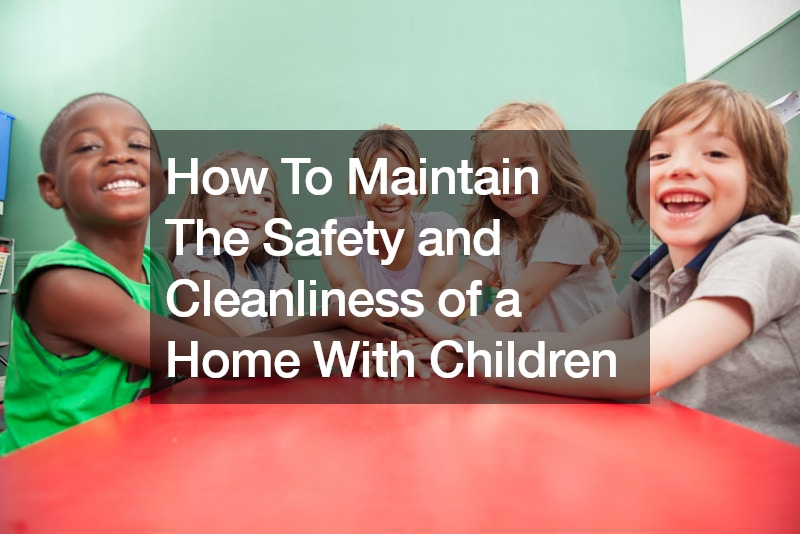
Maintaining a safe and clean home is essential, especially when you have children. A well-organized and tidy environment not only ensures their safety but also promotes their overall well-being. Children are naturally curious and energetic, which means they are often exploring their surroundings. This makes it crucial to create a space that is both secure and clean. By implementing some practical strategies and regular routines, you can make your home a safe haven for your little ones. In this article, we will provide you with simple and effective tips to keep your home safe and clean, making it a perfect place for your children to grow and thrive.
1. Organize Toys and Belongings

Keeping toys and belongings organized is a key step in maintaining a clean and safe home. Designating specific storage areas for toys can help create a clutter-free environment. Use bins and shelves for easy access and cleanup, making it simpler for both you and your children to find and store their favorite items.
Teach children the importance of putting away their toys after playtime. This not only keeps the living space tidy but also instills good habits in them from an early age. For instance, if your garage door is frequently used as an entry point for the family, consider setting up a storage area near the entrance. This way, children can quickly drop off or pick up their outdoor toys, keeping the house more organized and ensuring that playthings are not scattered all over the place.
By creating a dedicated space for toys and encouraging your children to use it, you can maintain a cleaner, more organized home that is safe for everyone.
2. Childproof Your Home

Childproofing your home is crucial to ensure the safety of your children as they explore and play. Start by installing safety gates at the top and bottom of stairs to prevent falls. These gates act as barriers, keeping little ones away from potentially dangerous areas. For extra convenience and security, consider using automatic gates that can be easily opened by adults but remain secure against a child’s curious hands.
Covering electrical outlets with safety plugs is another important step. Children are naturally inquisitive and may try to insert objects into the outlets, which can be hazardous. Safety plugs block access and reduce the risk of electrical shocks.
Securing heavy furniture and appliances to the wall is also essential. Items such as bookcases, dressers, and even the water heater should be firmly anchored to prevent them from tipping over. Children often use furniture to pull themselves up or as climbing aids, and unsecured items can pose a serious danger.
By taking these childproofing measures, you create a safer environment where your children can play and explore with reduced risk of injury.
3. Regular Cleaning Routines

Maintaining a clean home requires consistent effort and a structured approach. Setting a daily schedule for tidying up helps keep your living space organized and reduces the accumulation of clutter. This routine can include tasks such as putting away toys, organizing books, and wiping down surfaces.
High-touch surfaces, such as doorknobs, light switches, and countertops, should be cleaned regularly to minimize the spread of germs. Using disinfectant wipes or sprays can make this task quick and efficient. For more extensive cleaning, consider hiring a local carpet cleaning company to deep clean carpets and rugs, ensuring they remain fresh and free from allergens.
Involving children in age-appropriate cleaning tasks can also make a significant difference. Teaching them to help with simple chores, like picking up toys or dusting, instills a sense of responsibility and helps maintain cleanliness. It’s also a good idea to periodically use drainage cleaners to keep sinks and bathtubs clog-free, ensuring a hygienic environment.
By establishing regular cleaning routines and involving the entire family, you can keep your home clean and safe for everyone.
7. Healthy Habits and Hygiene
Instilling healthy habits and good hygiene practices in children is fundamental to their overall well-being. Teaching them to wash their hands frequently, particularly before meals and after using the restroom, is crucial in preventing the spread of germs and illnesses. Proper handwashing techniques, such as using soap and scrubbing for at least 20 seconds, should be emphasized to ensure effectiveness.
Encouraging regular bathing and dental care routines is equally important. Making bath time enjoyable helps establish it as a daily habit, while ensuring children brush their teeth at least twice daily promotes oral health and reduces the risk of cavities and gum disease. These practices not only contribute to physical cleanliness but also bolster their immune systems, protecting against common infections.
Additionally, keeping hand sanitizers readily accessible throughout the house provides a convenient alternative for quick clean-ups when soap and water are unavailable. This habit reinforces the importance of cleanliness and hygiene, especially in environments where exposure to germs is frequent, such as schools or public places. By integrating these practices into daily routines, parents can help children develop lifelong habits that promote health and well-being.
8. Emergency Preparedness
Being prepared for emergencies is paramount to ensuring your family’s safety. A crucial step is to maintain a readily accessible first aid kit stocked with essentials like bandages, antiseptic wipes, and pain relievers. This kit should be kept in a known location and regularly checked to replenish supplies.
Teaching children how to respond in emergencies is equally important. Ensure they understand how to dial emergency services (like 911), provide their address clearly, and relay any pertinent information. Practicing mock emergency calls can familiarize them with the process and instill confidence.
Develop and regularly practice an emergency evacuation plan with your family. Identify primary and alternative exit routes from each room, and establish a meeting point outside. Practice drills periodically to reinforce these procedures, ensuring everyone knows what to do and where to gather in the event of a fire or other emergency.
9. Monitor Indoor Air Quality
The quality of indoor air directly impacts your family’s health. To maintain good indoor air quality, use air purifiers equipped with HEPA filters to capture allergens and pollutants. Regularly changing these filters ensures optimal performance.
Avoid smoking indoors to prevent exposure to harmful secondhand smoke, which can contribute to respiratory issues and other health problems, particularly in children. Encourage smokers to smoke outdoors and away from windows and doors to minimize indoor contamination.
When weather permits, open windows to promote natural ventilation. Fresh air circulation helps reduce indoor pollutants and maintain a healthier environment. This practice is especially beneficial during activities that generate airborne particles, such as cooking or cleaning.
10. Regular Inspections and Maintenance
Regular inspections and maintenance are essential for a safe and efficient home. Ensure smoke and carbon monoxide detectors are operational by testing them monthly and replacing batteries as needed. These detectors provide early warnings of fire and hazardous gas leaks, safeguarding your family.
Inspect children’s toys and household furniture regularly for signs of wear and tear. Repair or replace damaged items promptly to prevent accidents, such as choking hazards or falls.
Schedule routine maintenance for household systems, including plumbing, heating, and cooling. Professional inspections and servicing prevent potential breakdowns and ensure these systems operate safely and efficiently. Addressing minor issues early can also save on costly repairs in the long run, maintaining your home’s overall safety and comfort.
By incorporating these practices into your household routines, you can significantly enhance the safety, health, and functionality of your home for your family.







